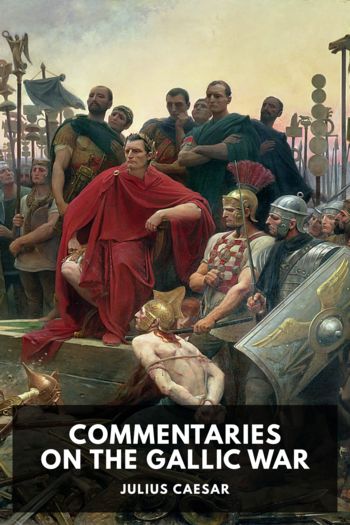Fateful Lightning: A New History of the Civil War & Reconstruction by Allen Guelzo (icecream ebook reader txt) 📗

- Author: Allen Guelzo
Book online «Fateful Lightning: A New History of the Civil War & Reconstruction by Allen Guelzo (icecream ebook reader txt) 📗». Author Allen Guelzo
The abyss of disunion had been avoided, but only for the time being. In only six years, a train of unsuspected consequences would throw an entirely new light on the popular sovereignty doctrine, and both it and the Compromise of 1850 would be wrecked with the stroke of a single judicial pen.
THE FAILURE OF COMPROMISE
The Compromise of 1850 had been created by a Whig (Henry Clay) and pushed through at last by the influence of a Whig president (Millard Fillmore). The laurels for this victory went to Stephen A. Douglas and the Democrats, and the Democrats used the political capital that the Compromise gave them to regain their political wind and win the presidential election of 1852. Both parties ran Mexican War heroes—the Whigs nominated Winfield Scott and the Democrats nominated Franklin Pierce of New Hampshire, who had begun the war as a private and ended up as a brigadier general—but Scott proved dull and aristocratic, while the handsome, likable Pierce stood on a pro-Compromise platform and won election easily.
There was a fly in the ointment of the Compromise of 1850, however. With all the attention in the debates of 1850 focused on the Mexican Cession territories, few people paid attention to the contents of the new Fugitive Slave Law, which Clay had included in the Compromise as a sop to wounded Southern feelings over California and popular sovereignty. There had actually been a Fugitive Slave Law on the federal books since 1793 (based on Article IV, Section 2 of the Constitution) which allowed Southern slaveholders to pursue and retrieve runaway slaves even in the free states. For that reason, until 1842 runaway slaves such as Josiah Henson had found it safer to run until they had made it to Canada and the safety of British law (where slavery was illegal and where the presumption of the law had always been in favor of freedom).
As Northern opinion turned colder and colder toward slavery, the free states offered pursuing slaveholders less and less cooperation, until in 1842 the Supreme Court (in Prigg v. Pennsylvania) ruled that the 1793 federal law did not necessarily require the cooperation of state magistrates and justices of the peace, especially where slave recaptures encroached on state due-process laws. The result, of course, was that numerous Northern state officials refused to cooperate at all in capturing runaways, and in some instances prosecuted slaveholders for kidnapping.
The new Fugitive Slave Law was an attempt to plug the holes Prigg v. Pennsylvania had put in the 1793 law. A federal enforcement apparatus was created, consisting of United States commissioners with powers to issue federal warrants for fugitive slaves and to make judgments in fugitive cases without a court hearing on the basis of as little as a simple affidavit of ownership from a slave owner (the commissioner was to receive a $10 fee for each fugitive returned to slavery and only $5 otherwise, so it was clear from the start what the preferred judgment would be). Ominously, the new law established no statute of limitations for runaways, which meant that runaways from as long as twenty years before (and more) could be captured and reenslaved. It threatened both local marshals and citizens with fines of up to $1,000 and liability for civil suits if they harbored fugitives or refused to cooperate in capture proceedings.32
This last provision was the most potentially explosive, for it virtually made every Northerner an accomplice to the betrayal and seizure of runaway slaves. Northerners who had enjoyed little or no contact with slavery, or who thought of slavery as merely an unpleasant moral abstraction, now were forced to consider how they would act if a slave owner or federal marshal in hot pursuit of a runaway should summon them to join a federal slave-catching posse.
Neither Clay nor Douglas had expected the Fugitive Slave Law to attract much controversy, if only because the actual number of runaways was fairly small compared to the entire slave population of the South. They at once learned how badly they had underestimated Northern reaction. Northerners who had never entertained a serious anti-slavery thought before were now treated to a series of public captures and extraditions of runaway slaves that only showed off slavery at its most revolting. Overeager slave owners and hired slave catchers tracked down longtime runaways such as Henry Long, who was haled before a federal judge “as the fugitive slave of John T. Smith, of Russell County, Virginia,” and carted off to Richmond, Virginia, to be sold at public auction on January 18, 1851; Euphemia Williams, who had run away from “William T. J. Purnell, of Worcester County, Maryland,” twenty-two years before, and whom they tried to drag, along with the six children she had raised in Philadelphia, back into slavery; or “a colored man, named Mitchum,” who was arrested in Madison, Indiana, in February 1851 by “George W. Mason, of Davies County, Ky.,” who had convinced a local justice of the peace that Mitchum “had left his service nineteen years before,” and who took him back to Kentucky.33
Not all of these pursuits ended well for the slave hunters, however. In September 1851 a Maryland slave owner named Edward Gorsuch crossed into Pennsylvania in pursuit of four runaways. Gorsuch enlisted the aid of a federal marshal and a posse and tracked the runaways to the home of





Comments (0)